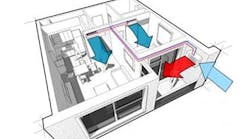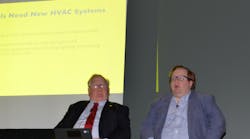A new study by The Freedonia Group, Cleveland, OH, says US demand for commercial refrigeration equipment will rise 4.6% per year to $9.4 billion in 2016. Transportation systems will remain the largest segment and grow the fastest, followed in pace by ice machines. Food and beverage distribution will be the fastest growing market, while foodservice will remain the largest.
Commercial Refrigeration Equipment to 2016 analyzes the $7.5 billion US commercial refrigeration equipment industry. It presents historical demand data for the years 2001, 2006 and 2011, and forecasts for 2016 and 2021 by market — including foodservice, food and beverage retail, food and beverage distribution, food and beverage production; and by product, including transportation refrigeration systems, refrigerators and freezers, beverage refrigeration equipment, display cases, ice machines, and refrigerated vending machines.
The study also considers market environment factors, details industry structure, evaluates company market share and profiles 39 industry players, including United Technologies, Ingersoll-Rand, and Manitowoc. To obtain the study, visit freedoniagroup.com.
Another refrigeration industry report — by IBISWorld —finds that with construction activity expected to pick up steam from 2012 to 2017, the walk-in and cabinet cooler manufacturing industry is poised for an especially vibrant rebound.
Read more at http://bit.ly/IBISonCoolers
ASHRAE/AHR Expo Survey Finds Positivity
Regarding overall HVACR industry growth, a recent survey of HVACR manufacturers by American Society of Heating, Refrigerating, and Air-Conditioning Engineers (ASHRAE) and the AHR Expo finds good news ahead for 2014. HVAC manufacturers surveyed described business prospects for 2014 as “excellent” (19%) or “good” (60%). Twenty-one percent described business prospects for 2014 as “fair.” (See p. 18).
Regarding consumption allowances, the EPA is proposing two methods of allocation.
EPA Seeks Comments on Final R22 Allocation
The US Environmental Protection Agency (EPA) in December issued a Proposed Rule for HCFC Allowance in 2015-2019. Regarding consumption allowances, the Agency is proposing two methods of allocation.
• A linear drawdown — which is the EPA’s preferred approach — would use the lowest proposed amount of HCFC refrigerants for 2014 (not the finalized 2014 allocation as the starting point, and end at zero in 2020 (see Table 1). Using this approach, the annual decrease in allowances would be the same each year. It is also proposing several variations on the linear drawdown, including starting the allocation slightly higher and lower than the lead proposal and ending at zero in 2018.
• An estimation approach for consumption is based on a “vintaging model” estimates of servicing need, recovery, and reuse, and could also account for transition to alternatives and any estimates of existing R22 inventory.
The EPA is proposing two options related to production allowances:
• issuing the maximum production allowances allowed for under the Montreal Protocol, after accounting for production allowances issued for other HCFCs in each year. This is EPA’s preferred approach, and would result in an annual allocation of about 28,000 metric tons, which is 21.7% of the R22 production baseline.
• issuing production allowances at the same level as consumption allowances.
For R123 — which originally replaced R11 — EPA is proposing to issue consumption allowances at 100% of baseline, which is about 2,000 metric tons, and is the maximum allocation allowed under the Clean Air Act.
For R124 — which originally replaced R114 — EPA is proposing to issue 200 metric tons of consumption allowances. EPA is proposing to issue production allowances at the same level as consumption.
For R142b — which has also been used as a replacement to R114 — EPA is proposing to issue 35 MT in 2015, which would be decreased annually by 5 MT, to 15 MT in 2019.
The proposed rule contains allocation scenarios for R225/ca/cb as a solvent, an amendment to regulations on production and use of HCFCs, and technical updates to the Refrigerant Reclamation Requirements, based on AHRI standards.
Read and comment on the entire proposed rule at bit.ly/EPAHCFCproposal.
ASHRAE Offers Refrigeration Commissioning Download
The American Society of Heating, Refrigerating and Air-Conditioning Engineers is offering a free download of its new Refrigeration Commissioning Guide for Commercial & Industrial Systems. The comprehensive guide contains 125 pages of instruction for commissioning systems in food retail, convenience stores, food and beverage facilities, food distribution centers, and industrial plants. Obtain the download by visiting bit.ly/ASHRAErefrigdownload.









